Escape From The City
With all the fuss given to it from the other teachers, Nikko was on my list of things-to-see for quite some time now so, with two days off, I took the opportunity to see the place for myself. I invited Keiko along as she’s a good laugh, and it makes life a lot easier when someone native is with you – ordering, booking, asking…
The train took two hours to reach the small city north of Tokyo. Actually, it took 101 minutes and something along these lines has been the train company’s slogan for years. Nikko is famous for two main features – the cluster of shrines and temples within the city, and the waterfalls and monkeys just outside.
The Nikko Free Pass (£22) was fantastic as it included a return ticket from Tokyo, discounts on the shrines and free buses around the area. The last was the biggest incentive, as each journey cost about £6 each time, so we saved a lot this way.
The first stop was Shinkyo Bridge. From what I learnt, there are many a snake story in Nikko’s history. It was at this location (supposedly) that a samurai was carried across the river on the back of two serpents. Well, it was a nice sight. Anyway, as you can see, the weather wasn’t exactly on our side. The fog made walking easy as there was no humidity, but the scenery was a bit misted.


Tosho-gu is the main shrine, which houses a famous carving which I’m sure you’ve heard of . In fact, it may be the most famous carving in the world – the three wise monkeys: hear no evil, speak no evil, see no evil.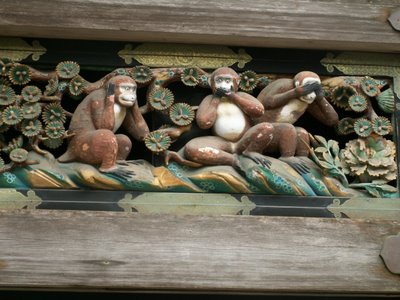



Actually, they weren’t that impressive or spectacular (but they are very famous). Housed above the royal stables, surrounded by many other sculptures, and pretty tiny, I preferred this monkey and his ‘sense of humour’.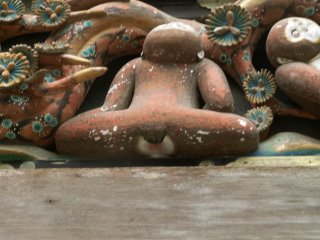 I suddenly remembered the wise words of Jody on her return from Nikko: “Don’t bother with the shrines; the monkeys are small, the sleeping cat is hidden above a door frame, and after all the stairs, there’s nothing there”. I laughed it off at the time but maybe she had a point.
I suddenly remembered the wise words of Jody on her return from Nikko: “Don’t bother with the shrines; the monkeys are small, the sleeping cat is hidden above a door frame, and after all the stairs, there’s nothing there”. I laughed it off at the time but maybe she had a point.

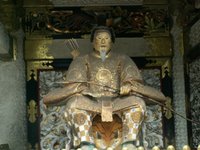
As all may guide books say, “some people never find the sleeping cat”. We did, but to be honest, it wouldn’t have been that cat-astrophic if we hadn’t. Again, tiny and unspectacular.
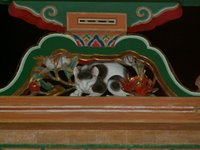
Furthermore, after the hundreds of stairs – the hell of Fuji flooded back – there was nothing at the top except a stone tomb where a samurai was buried. Still, the shrines weren’t that awful – they were beautiful, and the rain held off. This dragon water feature is cool. It looks like two dragons, but actually:
It looks like two dragons, but actually: Afterwards, we walked along the river and found an area dedicated to the deaths of young children, which was in front of a small waterfall and rapids. Very serene as it was only us and one old man fishing.
Afterwards, we walked along the river and found an area dedicated to the deaths of young children, which was in front of a small waterfall and rapids. Very serene as it was only us and one old man fishing.
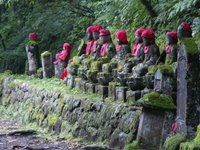

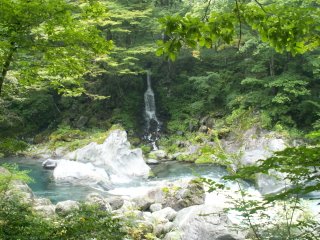



That evening, we headed to the cheap hotel we’d booked, and relaxed – Keiko teaching me Kanji and general chilling out. Although the first day wasn’t incredible, maybe this was because for all my 22 years all the Eastern shrines and temples I’d seen were crammed into six months, so overkill could be a good reason. Even still, the place was beautiful, old, and quiet – a nice escape/retreat/opposite to Tokyo life.
The second day was awesome. We headed North-East on the city bus to the waterfall area – starting with the furthest away and making our way back to the train station in time for our 101 minute train. The bus was actually a coach, and the journey was 1.5 hours up a mountain – and I thought the Yellow Buses of Bournemouth were exciting zooming around the Lansdowne Roundabout.



The Yutaki falls were fantastic – I don’t think I’ve ever seen a waterfall that close up before so it really was something. Between this fall and the next was a board-walk – literally planks of wood through woods, marshland and over rivers that you followed.

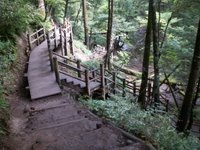
There are meant to be deer, monkeys and bears; the latter was the reason most people were carrying around bells with them although I’m not sure if a bell is really going to frighten a bear if he’s looking for lunch. Anyway, this sign made me laugh.
Doesn’t this tree look like something from ‘Sleepy Hollow’?
And then the sun came out! Just for five minutes, but if I could’ve chosen only five minutes the whole time, it would’ve been them. This area is known as the old battlefield because (again, supposedly) a snake fought a millipede here. The snake won. Of course.
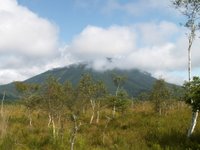
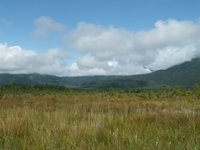

The walk was the best thing I did in Nikko as it was different to anything I’ve done before and every 5 minutes was a different scene. There were a lot of children on school trips and a four year old boy ran up to me, using my level of broken Japanese to tell me he saw three deer. It was so cute as he was speaking so fast and so seriously as if it was the most important thing in the world. We didn’t see any monkeys or bears but we saw the deer that the boy had been so excited about. Make your own joke about Bambi here because, truth be told, I can’t think of one.

More rapids further in the journey, but when we arrived at Kegon Falls which is famous in Japan, the fog was so bad that we couldn’t see it. Didn’t matter too much as we’d seen other great waterfalls. And you don’t want to see everything all of the time; otherwise, what do you see next time?




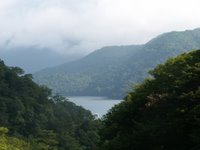
As compensation, the fog caused this cool effect of the sun breaking through the trees.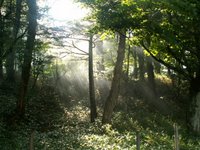

The train home was fine, and we both agreed that it was a great way to forget about work for two days.



1 comment:
Really! I thought he looked familiar...
And that plank of wood - Pinocchio's brother.
Post a Comment